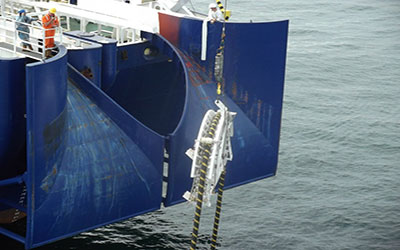
Although there have been power cables in the marine environment for many decades, there have been relatively few in number until fairly recently. Those that exist are predominately national or short haul international cables, and in terms of total kilometres are rather limited. Certainly this is the case when compared with telecoms cables, which have traditionally numbered hundreds of thousands of kilometres laid on the sea bed. As a result, the repair of power cables has very much been a niche market revolving around securing and mobilising VOOs (vessels of opportunity) or framework agreements, the latter mostly with the original cable installer/manufacturer and their specialist repair assets.
The financing of these repairs has always rested with the insurance industry, which because of the relative limited number of cables and faults, has been a model that has proved suitable for the majority of parties. However, with increasing awareness of climate change and the subsequent desire for more renewable and cleaner power sources, there has been a big push (particularly in the European region) for the development of large amounts of offshore wind capacity. This has led to a significant increase in power cable sea bed kilometres to service and connect wind farms to their respective national grids. In the European region specifically, there has also been an increase in the number of international links, to more effectively harness and transmit electricity around the various power markets.
The upshot is an increased risk profile for power cables, and correspondingly more faults, whether from manufacturing or from third party aggression. As a consequence, there has been a marked increase in the number of insurance claims.
The increased cost of liability has led insurers and some national/regional government bodies to look at ways of reducing costs and strengthening the supply chain. A further aim is to enable a more rapid and streamlined response times – insurance-based repair models normally incur a significant delay (months) between the fault occurring and a repair being undertaken.
Power cable repairs costs are frequently in the multiple of millions. This level of expenditure is understandable as such projects necessitate the diversion of a dedicated specialist installation vessel from its existing activities, and more often than not, sail it from a distant global location. Additionally, depending on the installation equipment already mobilised on board, it may be necessary to have a period of reconfiguration prior to commencing the power cable repair. Alternatively, the deployment of a VOO means having to locate and mobilise all the specialist equipment, such as chutes, tensioners, compatible jointers and jointing equipment (as well as some form of cable storage arrangement), prior to sailing.
Correspondingly, everything has to be totally demobbed after the operation, with these activities requiring the cable owner or insurer to cover the cost of the VOO while this takes place, which could cost anywhere between £65,000 and £150,000 per day. Assuming a seven-day mobilisation/configuration, and corresponding demobilisation, the pre- and post-operational activities can cost anywhere from £0.91 million to £2.1 million, even before sailing to the fault site and undertaking any survey/inspection or repair activity.
These costs do not even consider the cost of service interruption; this was calculated for a 300MW UK windfarm in November 2014 by Transmission Investments LLP to be in the region of £3 million to £12 million per month depending on the number of export cables available for transmission back to the grid. In this instance, the higher figure is where there is only one export cable servicing the wind farm, while the lower figure represents two cables.
Traditionally, telecom agreements (in particular maintenance zones), have a vessel or vessels on standby close to the specific regions known to have high fault rates, and are usually able to sail for cable repair within 24/36 hours of being called out. It is this preparation, localisation and cost effectiveness that the UK’s OFGEM, along with the support of some of the larger UK’s OFTO’s (Offshore Transmission Operators), wishes to replicate for all the UK’s offshore wind farm export cables, national links and inter-connectors. It is estimated that there will be around 20,000km of power cable installed in northern European waters by 2030, which means that there are likely to be between 10 and 40 large cable repair projects in the North Sea per year by that date.